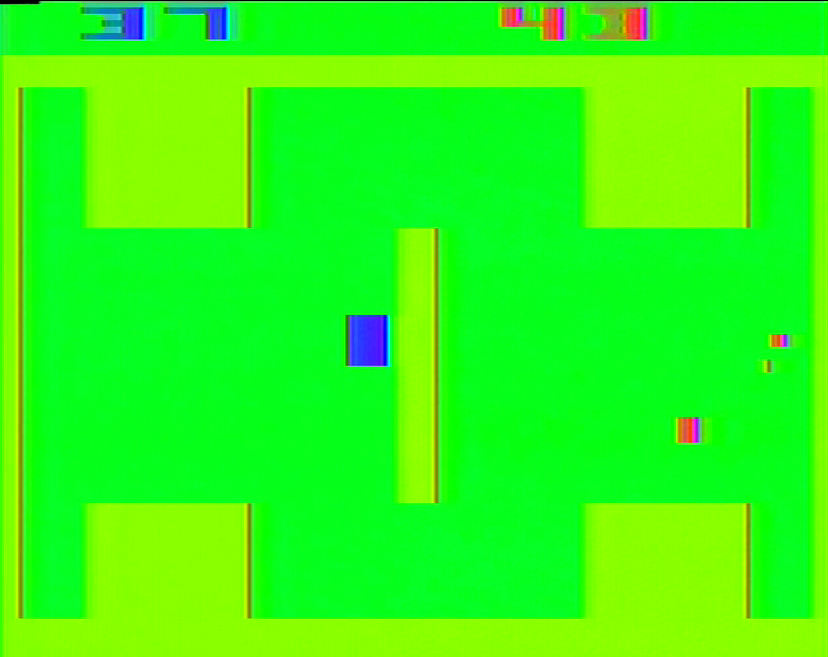
When discussing and playing Atari VCS games, a certain degree of abstraction is expected. Backgrounds are low resolution, and the missile and ball sprites are quite limited in appearance. As such, chunky sprites and blocks representing people, footballs, basketball hoops, cars and so on are the norm. Even by these standards, Miniature Golf, also known as Arcade Golf in its Sears release, is an incredibly abstract take on golf’s fast-paced, wacky cousin.
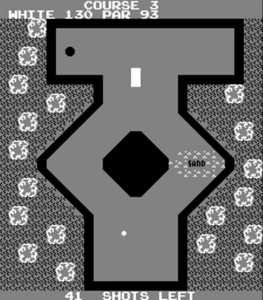
Making a game out of this sport makes perfect sense in context. For the unfamiliar, mini golf, or putt-putt golf in some parts of the world, puts players in small, specially designed courses where they have to putt a golf ball past obstacles, around tricky corners, up ramps, and into the cup. The game was in the midst of a boom period through the 1970s, and Atari was capitalizing. Miniature Golf was written by Tom Reuterdahl, who unfortunately declined to be interviewed about his time at Atari beyond confirming his authorship. The Sears name of Arcade Golf suggests his VCS take on the sport could have some connection to an unreleased Atari arcade game called Mini-Golf. Both games take an overhead approach to the courses, tasking players with knocking their ball through the course by indicating their angle of approach and power with a cursor. The course layouts were already rather generic on the arcade game, but are even more abstract on the VCS conversion; using the background graphics, each course is essentially a puzzle of geometric shapes that the players must navigate their ball through. Much like the actual sport, each time you hit the ball you score a point, with a goal of getting through the game with the fewest points possible.
In true mini golf fashion, Miniature Golf is really designed around tricky bank shots and good timing to avoid traps and obstacles in the nine different courses you play through. This game was released in the period before Nintendo’s Golf really standardized the meter-based control scheme, but the idea of using a cursor to control power and angle is an interesting, if flawed, solution. The further away the cursor from the ball, the more power is behind the shot; the position of the cursor in relation to the ball controls the angle it is hit at. The difficulty switches adjust the friction for each player’s ball – when flipped to A, the ball will zip along further than it normally does. This control scheme works to a point, but depending on the ball’s position it can hinder the game and make it needlessly annoying.
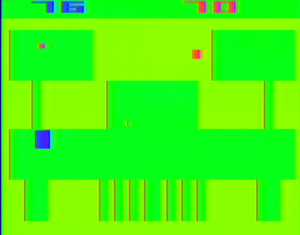
This is especially true if the ball is up against the side of the screen, as the player can only move the cursor a short distance out to the edge before they’re stopped – in turn leaving them with an incredibly weak shot that won’t go far. This can prove cumbersome when you otherwise have your angle set up and you just can’t get the distance you need to make it work in one turn. This doesn’t seem like it would be a huge deal at first, but it drags the game down and makes it that much harder to get a good score. It can also lead to your shots getting blocked on courses that have moving obstacles, as the lack of power knocks off the timing you hope for. You can try and adjust for it by moving to the other side and trying for a bank shot – this does work, but you do sacrifice some of your accuracy in not being able to line up your shots direct.
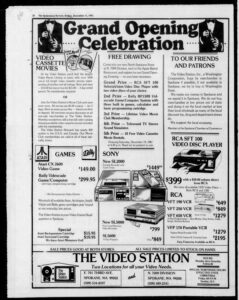
Miniature Golf appears to have had a short shelf life on the VCS. Atari dropped it by the January 1981 CES show, and while this is purely supposition, the company publishing a straightforward Golf game in 1980 may have had something to do with it. Atari Corporation brought back the game to sell a whopping 109 copies in 1987 and 88; if you told me that was solely to get rid of old stock I would believe it. Reviews from its heyday were rather mixed but generally fell on the side of it not having much to do with actual miniature golf. Xenia Gazette columnist Dick Cowan complained that it was difficult to get the ball around objects and into the cup. Arnie Katz, Bill Kunkel, and Joyce Worley wrote their thoughts about the game twice; the first time was in the April 1980 Video magazine column Arcade Alley, where they noted that while unrealistic and arcadey, it combined bumper cars, mini golf and billiards to create an “intriguing game of obstacles” for players to overcome. These sentiments were largely echoed in the July 1982 Electronic Games magazine writeup on sports video games, where Miniature Golf was mentioned as being withdrawn from the market and not terribly realistic, with a ball that bounced around like one from billiards. They did praise it for being challenging and having “fast action,” for which it certainly qualifies.
Despite not being a terribly popular game, Reuterdahl’s work did serve as the basis for a surprisingly robust hack created in 2006 by Glenn Bussell, known as Miniature Golf Plus. Bussell had developed a editing tool for the original Miniature Golf game and held a level design competition that drew around 60 entries. Since this hack utilizes a 4 kilobyte cartridge instead of the original’s 2k, the extra space allows for hole layouts with double the vertical resolution. With this in mind, Bussell and his contest entrants put together a new nine-hole golf course that is a rather impressive love letter of sorts to the original and the VCS era in general. Bussell, I should add, was at one point asked on Atariage if this allowed for an 18-hole course, and he indicated that while the space was there, the code was otherwise arranged for only nine.
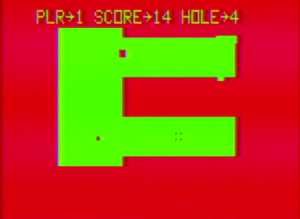
Miniature Golf as a video game concept seems to have been oddly overlooked for years. This might have had something to do with the relatively low resolutions and memory that early consoles had to work with, but it wasn’t entirely a lost cause. Thanks to the unique indie developer scene for Bally’s Professional Arcade console that created games using its robust BASIC programming carts and cassette tape interfaces, that specific console saw a few attempts at bringing the game home. Esoterica published Mini Golf (also known as Putt-Putt Golf) for the Bally Professional Arcade in March 1981 that ran through the system’s BASIC cart. This particular version has commonalities with Atari’s in terms of control schemes, but features even more simplistic course designs – presumably due to the limited memory Bally BASIC games had to work within. It also features an unfortunate glitch where the ball can get stuck inside the walls; fortunately after six putts the game considers you to have hit the stroke limit and moves you along to the next one of six holes.
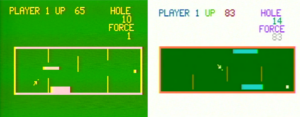
Another Bally BASIC author, Mike White, wrote his own take with Put-Put Golf in December 1982 for the original Bally BASIC cart; this was later converted to the later AstroBASIC variant in March 1985. This was rewritten in 1993 by White to use the Blue RAM BASIC third-party memory expansion, which added more color and speed, but was otherwise essentially the same game; he indicated that this was done for usage in multicarts. White’s game gets around the cursor issue by having you choose one of eight directions to aim, and lets you determine your force by twisting the controller’s knob. The courses are a bit devious, with both static and moving barriers, water hazards, sand traps, and inexplicably land mines on the 18th hole. On the downside, being limited to eight directions means that sometimes you end up wasting shots just to align the ball correctly. That said, this is probably the finest mini golf you’re going to play on a game console from this era, with or without the RAM expansion. Later revisions added the “random line erase routine” written by L&M Software’s Nautilus, and a screen interrupt for the score card in even later editions; White said the program loops is incredibly simple for detecting handling bounces, simply checking the approaching pixel for a 0 or 1 and reversing the direction on a hit.
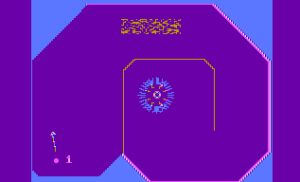
The concept cropped up a few times on home computers at the time, where memory and screen resolution were better suited to making the game work. An author named Mitch Voth wrote a 9-Hole Mini Golf game for the TRS-80 and Atari’s 8-bit computers that saw its BASIC code published in Softside magazine in 1981. This version seemed to be somewhat similar to the VCS game. A decidedly more advanced Apple II mini golf game written by Steve A. Baker for Softape would also go on to be the basis for an unpublished Atari 5200 conversion when Baker took a job at Atari to work on 5200 software (or possibly it’s the other way around – information on the Apple version is scarce). This game used the high-resolution modes on the 5200 and Apple II, with the 5200 using the controller keypads to adjust angles and power. According to the website Atariprotos.com, this version of the game was shelved by Atari due to the funky colors the console’s high-resolution graphic mode forced it into, but by all rights any 5200 game that doesn’t require players to work with the controller’s non-centering analog stick can’t be all that bad. The control scheme also avoids the problems seen in the earlier VCS game, and the higher resolution graphics allow for more elaborate and understandable – if still rather abstract – courses compared to its older counterpart. Miniature golf did eventually see an arcade release though, years after Atari shelved its original attempt, as Bally Sente issued Mini Golf in 1985.
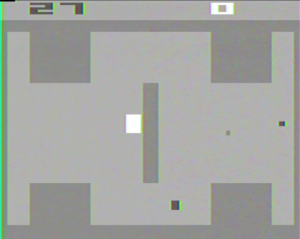
Miniature Golf on the VCS may not be a real highlight of the library, but it’s actually an interesting one – this is a game that really tries to do something unique and make a breezy real-world pastime into a breezy video game experience. It doesn’t succeed entirely due to its control issues, and the courses may be esoteric, but it is still an interesting diversion with another player. This is also, to my knowledge, Reuterdahl’s sole software outing on the platform, and while he may not have developed an instant classic, his game is the exact level of quirky that defines 1970s VCS development.
Sources:
Tom Reuterdahl, correspondence with the author, Sept. 16, 2019
Mike White, correspondence with the author, November 2019-May 2020
Miniature Golf – Atari 5200, Atariprotos.com
Arcade Alley, Video, April 1980
Tour the Video Links, Electronic Games, July 1982
Softside, February 1981
Xenia Gazette, April 14 1979
Atari Corp. 2600 Sales figures, 1986-1990
Atari History Timelines, Michael Current
Ballyalley.com
Cursor, March 1981
Miniature Golf Plus, videofringe.com(Wayback Machine)
Miniature Golf Editor, videofringe.com(Wayback Machine)
Resume, Steve A. Baker, sabgames.net(Wayback Machine)
Steve Baker, interview with Randy Kindig, ANTIC, Nov. 1 2015
Release date sources:
Miniature Golf (Atari VCS) – Source: New York Daily News, March 22 1979; Philadelphia Inquirer, April 8 1979; Xenia Gazette, April 14 1979
Mini Golf (Bally BASIC) – Cursor, March 1981
Put-Put Golf (Bally BASIC, AstroBASIC, Blue Ram BASIC) – Mike White himself
